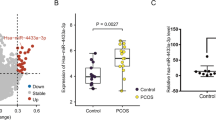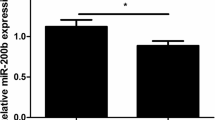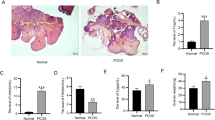Abstract
The aim of this study was to investigate the effect and mechanism of action of miR-1298-5p in polycystic ovary syndrome (PCOS). Granulosa cells were isolated from follicular fluid of patients with PCOS and healthy women, and the expression of miR-1298-5p and glutathione-disulfide reductase (GSR) mRNA in these cells was evaluated using reverse transcription-quantitative polymerase chain reaction (qRT-PCR). Clinical data were obtained from all subjects, and reproductive hormones and endocrine indices were assayed to analyze the correlation between miR-1298-5p and clinicopathological characteristics of patients with PCOS. Following transfection with the miR-1298-5p mimic or inhibitor and/or pcDNA3.1-GSR, LC3 immunofluorescence and transmission electron microscopy were used to evaluate autophagy in the COV434 human granulosa cell line. Additionally, western blotting was performed to detect LC3-II, Beclin 1, and p62 protein levels in COV434 cells. The interaction between miR-1298-5p and GSR was also examined. A PCOS rat model was established and injected with the miR-1298-5p antagomir, followed by measurement of body and ovary weights, histological examination, and autophagosome observation. The protein expression levels of GSR, LC3-II, Beclin 1, and p62 were determined in rat ovaries. miR-1298-5p was expressed at a high level, and GSR was downregulated in granulosa cells from patients with PCOS. In COV434 cells, miR-1298-5p inversely mediated GSR expression, and miR-1298-5p mimic transfection promoted autophagy, whereas GSR overexpression blocked miR-1298-5p mimic-promoted autophagy. In PCOS rats, miR-1298-5p inhibition reduced autophagy and alleviated abnormalities in follicular development. Overall, miR-1298-5p enhances autophagy in granulosa cells by downregulating GSR, thereby affecting PCOS development.








Similar content being viewed by others
Availability of data and materials
The datasets used or analyzed during the current study are available from the corresponding author on reasonable request.
References
Cabrera-Cruz H, Orostica L, Plaza-Parrochia F, Torres-Pinto I, Romero C, Vega M (2020) The insulin-sensitizing mechanism of myo-inositol is associated with AMPK activation and GLUT-4 expression in human endometrial cells exposed to a PCOS environment. Am J Physiol Endocrinol Metab 318:E237–E248
Choi JY, Jo MW, Lee EY, Yoon BK, Choi DS (2010) The role of autophagy in follicular development and atresia in rat granulosa cells. Fertil Steril 93:2532–2537
Conway G, Dewailly D, Diamanti-Kandarakis E, Escobar-Morreale HF, Franks S, Gambineri A, Kelestimur F, Macut D, Micic D, Pasquali R, Pfeifer M, Pignatelli D, Pugeat M, Yildiz BO, Group EPSI (2014) The polycystic ovary syndrome: a position statement from the European Society of Endocrinology. Eur J Endocrinol 171:P1-29
Cui Z, Liu L, Kwame Amevor F, Zhu Q, Wang Y, Li D, Shu G, Tian Y, Zhao X (2020) High expression of miR-204 in chicken atrophic ovaries promotes granulosa cell apoptosis and inhibits autophagy. Front Cell Dev Biol 8:580072
Diaz M, Bassols J, Lopez-Bermejo A, de Zegher F, Ibanez L (2020) Low circulating levels of miR-451a in girls with polycystic ovary syndrome: different effects of randomized treatments. J Clin Endocrinol Metab 105
Eisenberg I, Nahmias N, Novoselsky Persky M, Greenfield C, Goldman-Wohl D, Hurwitz A, Haimov-Kochman R, Yagel S, Imbar T (2017) Elevated circulating micro-ribonucleic acid (miRNA)-200b and miRNA-429 levels in anovulatory women. Fertil Steril 107:269–275
Fu X, He Y, Wang X, Peng D, Chen X, Li X, Wan Q (2018) MicroRNA-16 promotes ovarian granulosa cell proliferation and suppresses apoptosis through targeting PDCD4 in polycystic ovarian syndrome. Cell Physiol Biochem 48:670–682
Gilardini Montani MS, Santarelli R, Granato M, Gonnella R, Torrisi MR, Faggioni A, Cirone M (2019) EBV reduces autophagy, intracellular ROS and mitochondria to impair monocyte survival and differentiation. Autophagy 15:652–667
Guan H, Sun C, Gu Y, Li J, Ji J, Zhu Y (2021) Circular RNA circ_0003028 contributes to tumorigenesis by regulating GOT2 via miR-1298-5p in non-small cell lung cancer. Bioengineered 12:2326–2340
Imbar T, Eisenberg I (2014) Regulatory role of microRNAs in ovarian function. Fertil Steril 101:1524–1530
Jiang L, Huang J, Li L, Chen Y, Chen X, Zhao X, Yang D (2015) MicroRNA-93 promotes ovarian granulosa cells proliferation through targeting CDKN1A in polycystic ovarian syndrome. J Clin Endocrinol Metab 100:E729-738
Khan HA, Zhao Y, Wang L, Li Q, Du YA, Dan Y, Huo LJ (2015) Identification of miRNAs during mouse postnatal ovarian development and superovulation. J Ovarian Res 8:44
Li D, You Y, Bi FF, Zhang TN, Jiao J, Wang TR, Zhou YM, Shen ZQ, Wang XX, Yang Q (2018) Autophagy is activated in the ovarian tissue of polycystic ovary syndrome. Reproduction 155:85–92
Li H, Liu Q, Chen Z, Wu M, Zhang C, Su J, Li Y, Zhang C (2021) Hsa_circ_0110757 upregulates ITGA1 to facilitate temozolomide resistance in glioma by suppressing hsa-miR-1298-5p. Cell Death Dis 12:252
Li X, Qi J, Zhu Q, He Y, Wang Y, Lu Y, Wu H, Sun Y (2019) The role of androgen in autophagy of granulosa cells from PCOS. Gynecol Endocrinol 35:669–672
Liu G, Liu S, Xing G, Wang F (2020) lncRNA PVT1/microRNA-17-5p/PTEN axis regulates secretion of E2 and P4, proliferation, and apoptosis of ovarian granulosa cells in PCOS. Mol Ther Nucleic Acids 20:205–216
Liu T, Liu Y, Huang Y, Chen J, Yu Z, Chen C, Lai L (2019) miR-15b induces premature ovarian failure in mice via inhibition of alpha-Klotho expression in ovarian granulosa cells. Free Radic Biol Med 141:383–392
Long W, Zhao C, Ji C, Ding H, Cui Y, Guo X, Shen R, Liu J (2014) Characterization of serum microRNAs profile of PCOS and identification of novel non-invasive biomarkers. Cell Physiol Biochem 33:1304–1315
Ma J, Xu LY, Sun QH, Wan XY, BingLi (2021) Inhibition of miR-1298–5p attenuates sepsis lung injury by targeting SOCS6. Mol Cell Biochem
Mu L, Sun X, Tu M, Zhang D (2021) Non-coding RNAs in polycystic ovary syndrome: a systematic review and meta-analysis. Reprod Biol Endocrinol 19:10
Murri M, Insenser M, Fernandez-Duran E, San-Millan JL, Escobar-Morreale HF (2013) Effects of polycystic ovary syndrome (PCOS), sex hormones, and obesity on circulating miRNA-21, miRNA-27b, miRNA-103, and miRNA-155 expression. J Clin Endocrinol Metab 98:E1835-1844
Murri M, Insenser M, Fernandez-Duran E, San-Millan JL, Luque-Ramirez M, Escobar-Morreale HF (2018) Non-targeted profiling of circulating microRNAs in women with polycystic ovary syndrome (PCOS): effects of obesity and sex hormones. Metabolism 86:49–60
Naigaonkar A, Dadachanji R, Hinduja I, Mukherjee S (2021) Altered redox status may contribute to aberrant folliculogenesis and poor reproductive outcomes in women with polycystic ovary syndrome. J Assist Reprod Genet
Oh BM, Lee SJ, Cho HJ, Park YS, Kim JT, Yoon SR, Lee SC, Lim JS, Kim BY, Choe YK, Lee HG (2017) Cystatin SN inhibits auranofin-induced cell death by autophagic induction and ROS regulation via glutathione reductase activity in colorectal cancer. Cell Death Dis 8:e2682
Rotterdam EA-SPcwg, (2004) Revised 2003 consensus on diagnostic criteria and long-term health risks related to polycystic ovary syndrome (PCOS). Hum Reprod 19:41–47
Salehi R, Mazier HL, Nivet AL, Reunov AA, Lima P, Wang Q, Fiocco A, Isidoro C, Tsang BK (2020) Ovarian mitochondrial dynamics and cell fate regulation in an androgen-induced rat model of polycystic ovarian syndrome. Sci Rep 10:1021
Shen M, Cao Y, Jiang Y, Wei Y, Liu H (2018) Melatonin protects mouse granulosa cells against oxidative damage by inhibiting FOXO1-mediated autophagy: Implication of an antioxidation-independent mechanism. Redox Biol 18:138–157
Sumarac-Dumanovic M, Apostolovic M, Janjetovic K, Jeremic D, Popadic D, Ljubic A, Micic J, Dukanac-Stamenkovic J, Tubic A, Stevanovic D, Micic D, Trajkovic V (2017) Downregulation of autophagy gene expression in endometria from women with polycystic ovary syndrome. Mol Cell Endocrinol 440:116–124
Vahdat-Lasemi M, Hosseini S, Jajarmi V, Kazemi B, Salehi M (2019) Intraovarian injection of miR-224 as a marker of polycystic ovarian syndrome declines oocyte competency and embryo development. J Cell Physiol 234:13858–13866
Wu HL, Heneidi S, Chuang TY, Diamond MP, Layman LC, Azziz R, Chen YH (2014) The expression of the miR-25/93/106b family of micro-RNAs in the adipose tissue of women with polycystic ovary syndrome. J Clin Endocrinol Metab 99:E2754-2761
Xia H, Zhao Y (2020) miR-155 is high-expressed in polycystic ovarian syndrome and promotes cell proliferation and migration through targeting PDCD4 in KGN cells. Artif Cells Nanomed Biotechnol 48:197–205
Xu B, Zhang YW, Tong XH, Liu YS (2015) Characterization of microRNA profile in human cumulus granulosa cells: identification of microRNAs that regulate Notch signaling and are associated with PCOS. Mol Cell Endocrinol 404:26–36
Xue Y, Lv J, Xu P, Gu L, Cao J, Xu L, Xue K, Li Q (2018) Identification of microRNAs and genes associated with hyperandrogenism in the follicular fluid of women with polycystic ovary syndrome. J Cell Biochem 119:3913–3921
Zhang C, Hu J, Wang W, Sun Y, Sun K (2020a) HMGB1-induced aberrant autophagy contributes to insulin resistance in granulosa cells in PCOS. FASEB J 34:9563–9574
Zhang X, Li X, Fu X, Yu M, Qin G, Chen G, Huang C (2021) Circular RNA TAF4B promotes bladder cancer progression by sponging miR-1298-5p and regulating TGFA expression. Front Oncol 11:643362
Zhang X, Xiao H, Zhang X, E Q, Gong X, Li T, Han Y, Ying X, Cherrington BD, Xu B, Liu X, Zhang X, (2020b) Decreased microRNA-125b-5p disrupts follicle steroidogenesis through targeting PAK3/ERK1/2 signalling in mouse preantral follicles. Metabolism 107:154241
Zhou J, Peng X, Mei S (2019) Autophagy in ovarian follicular development and atresia. Int J Biol Sci 15:726–737
Acknowledgements
Thanks for all the contributors and participants.
Funding
This research was funded by the grants from the National Natural Science Foundation of China (No. 81670004; No. 32072738); Guangxi Key Laboratory of Biological Targeting Diagnosis and Therapy Research Fund; Guangxi Natural Science Fund Project (No. 2017GXNSFAA198163); Nanning Scientific Research and Technology Development Program (No.20213024); Guangxi National Natural Science Foundation (No. 2020GXNSFAA159099); Nanning Qingxiu District Science and Technology Project (No. 2020025); Nanning Jiangnan District Project (No. 202001206); and Key R & D Program of Scientific Research and Technology of Nanning Liangqing District (No. 202009).
Author information
Authors and Affiliations
Contributions
XCL and SHS conceived the ideas. SHS, XCL, and LMJ designed the experiments. LMJ, LXD, WT, and ZZ performed the experiments. LCZ and HZL analyzed the data. LMJ, LXD, and WT provided critical materials. ZZ and LCZ wrote the manuscript. SHS supervised the study. All the authors have read and approved the final version for publication.
Corresponding author
Ethics declarations
Ethical approval and consent to participate
The study protocol was approved by the ethic committee of Shandong First Medical University. Written informed consent was obtained from each patient participated in this study prior to study enrollment. Efforts were made as much as possible to minimize the pain of animals.
Competing interests
The author declares no competing interests.
Additional information
Publisher's Note
Springer Nature remains neutral with regard to jurisdictional claims in published maps and institutional affiliations.
Rights and permissions
Springer Nature or its licensor (e.g. a society or other partner) holds exclusive rights to this article under a publishing agreement with the author(s) or other rightsholder(s); author self-archiving of the accepted manuscript version of this article is solely governed by the terms of such publishing agreement and applicable law.
About this article
Cite this article
Xu, C., Luo, M., Liu, X. et al. MicroRNA-1298-5p in granulosa cells facilitates cell autophagy in polycystic ovary syndrome by suppressing glutathione-disulfide reductase. Cell Tissue Res 392, 763–778 (2023). https://doi.org/10.1007/s00441-023-03747-9
Received:
Accepted:
Published:
Issue Date:
DOI: https://doi.org/10.1007/s00441-023-03747-9




